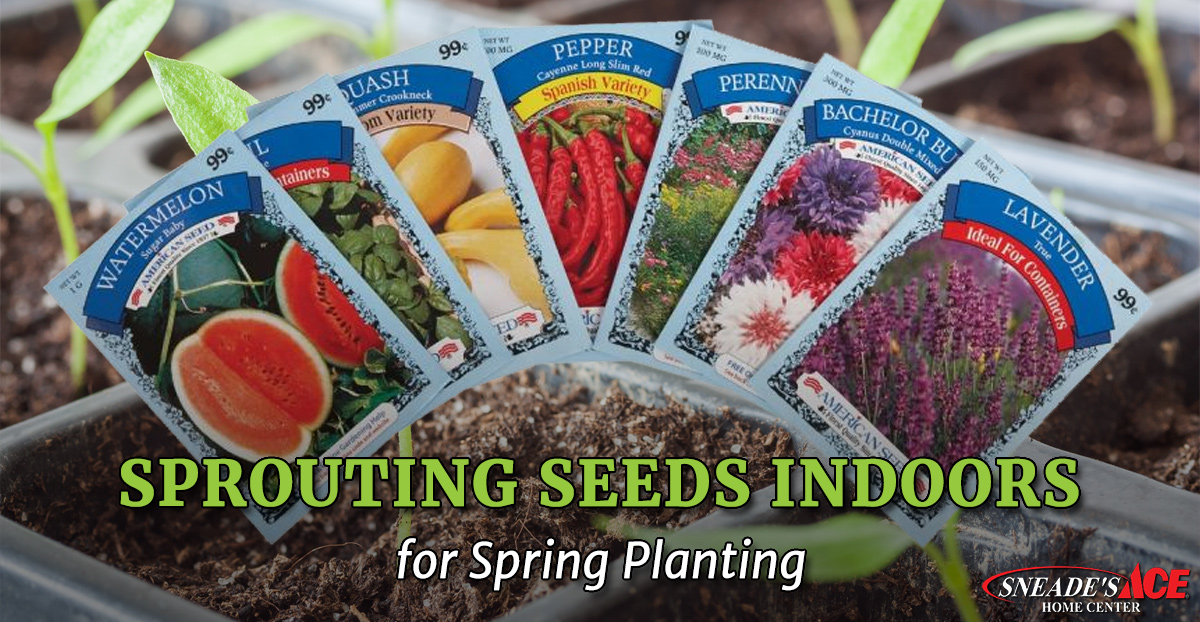
Even though we are nearing the end of another Maryland winter (hopefully), it’s never too early to begin thinking and planning your summer garden. A great way to begin using your green thumb for the upcoming gardening season is to plant seeds indoors before spring. Sprouting seeds indoors during the winter will get you a head start on planting your garden. Indoor sprouting is when seeds are planted in small containers and cared for inside. They are then transplanted to an outdoor garden when the frost season is over. If sprouting seeds indoors is new to you, you may have questions, and Sneade’s has the answers.
What Kind of Seeds Should I Sprout Indoors?
Vegetable seeds are an excellent option to start indoors; however, not all vegetable plants are the same. While there is no hard-and-fast rule about which vegetable plants should be transplanted, some do better in the process than others.
Tender vegetables like peppers, eggplant, and tomatoes are susceptible to the cold temperatures of spring, so they do well when they are sprouted inside.
Cauliflower, celery, eggplant, and peppers have a slower root development, so giving them extra time to sprout indoors is a good advantage.
Broccoli, brussels sprouts, lettuce, and cabbage are other crops you can confidently start indoors.
Not all vegetables work well transplanted. Root vegetables like carrots and beets don’t like to disturb their root system, so it’s wisest to plant these veggies directly into the outdoor garden.
How Do I Start?
Before you even buy your potting soil or gather your growing containers, make a list of what you would like to grow. Make sure you don’t over plan and inadvertently overcrowd your garden. A good rule of thumb is to think of your garden as one-quarter the size it will really be. This allows for good spacing between your vegetables.
Once you have made a plan, purchase your seeds. Stop in at any Sneade’s location to shop our selection of seeds.
I Have the Seeds. Now What?
When you have your seeds, it’s time to read the back of the packet. They may direct you to soak, chill, or scratch seeds before planting.
Next, gather your seedling containers. Egg cartons and individual yogurt cups work well for the earliest stages of seedlings. As they grow, you may need to transplant the seedlings to a bigger container. Make sure each container has a hole poked in the bottom for drainage.
Be sure to label your containers with what you’re planting so you don’t lose track.
How Do I Sow the Seeds?
Fill your containers with all-purpose potting mix. Don’t use regular potting soil as it’s not fine enough for many seeds’ roots to penetrate the soil easily.
Use your fingertips to make shallow depressions. Plant the seeds at the depth indicated on the seed packet.
Once all seeds are planted, sprinkle more potting mix over the top. Gently skim your fingers over the containers to ensure you’ve buried all the seeds.
Now it’s time to water your seeds. You must take care to do this relatively gently, so you don’t dislodge the seeds from the soil. The water stream from a pitcher may have too much force, causing the seeds to float to the top of the soil. Misting with a water sprayer is gentle but can take a long time to soak the soil. A happy medium is to use a turkey baster. This will water the soil without causing too much disruption.
Cover your containers loosely with clear plastic wrap to keep them from drying out too quickly. Poke a few holes through the plastic wrap to give your seedlings good ventilation.
Once your seedlings begin to appear, remove the plastic wrap and place your containers in a bright window or under a grow light.
When Should I Begin My Indoor Seeds?
You can begin your indoor seeds six weeks before the last frost in your area. It is easy to get frost dates for your zip code. Any online search engine can provide a frost calendar.
Remember, gardening can be a lot of trial and error. Part of the fun of gardening is learning what works and what doesn’t work. Don’t let gardening frustrate you. Any of Sneade’s Gardening Centers would love to help you or answer your seed sprouting questions.
